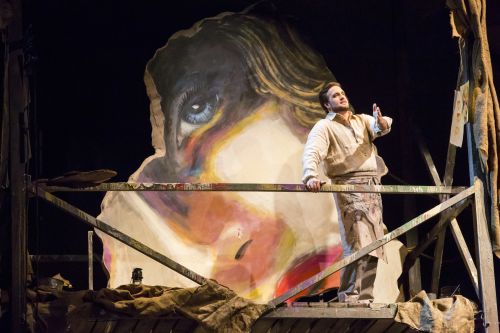 United States Puccini: Tosca, Lyric Opera of Chicago, Vladimir Jurowski (conductor), Civic Opera House, Chicago, 24.1.2015 (JLZ)
United States Puccini: Tosca, Lyric Opera of Chicago, Vladimir Jurowski (conductor), Civic Opera House, Chicago, 24.1.2015 (JLZ)

Cast:
Tosca: Tatiana Serjan
Cavaradossi: Brian Jagde
Scarpia: Evgeny Nikitin
Angelotti: Richard Ollarsaba
Sacristan: Dale Travis
Spoletto: Rodell Rosel
Sciarrone: Bradley Smoak
Shepherd: Annie Wagner
Jailer: Anthony Clark Events
Production:
Conductor: Dmitri Jurowski
Director: John Caird
Designer: Bunny Christie
Lighting Designer: Duane Schuler
Chorus Master: Michael Black
Children’s Chorus Master: Josephine Lee
It’s difficult to imagine that Joseph Kerman’s dismissal of Puccini’s Tosca (1900) as a “shabby little shocker” has much relevance for new productions, like the current one by Lyric Opera of Chicago and Houston Grand Opera. This staging raises questions about the source of the work, the 1887 play La Tosca by French dramatist Victorien Sardou, and its relationship to Puccini’s opera. George Bernard Shaw’s comment that Sardou’s play could serve as an opera is certainly valid, since modern audiences are most familiar with Puccini’s version. But in this co-production, the “original source” is referenced several times and competes with Puccini’s score.
Director John Caird brings the backstory from Sardou’s play into the present by placing a young woman (Annie Wagner) on stage in each act to remind the audience of Tosca’s roots. In Act I the young Tosca appears veiled in blue light, with her placement near the statue of the Madonna suggesting an apparition of the Virgin Mary. It’s unfortunate that this innovative gesture is ambiguous, especially when the image appears to condone Tosca’s murder of Scarpia in the second act. In Act III, the young Tosca also serves as the shepherd, and then later appears above the window from which Tosca falls and disappears at the final curtain.
The young Tosca is present in other ways, with Tosca’s costumes reflecting the peasant background of Sardou’s character in lieu of the glamour often used to depict the title character. With the staging updated to the late nineteenth century, the coarseness of that age is part of the production, without the elegance that gives ironic bite to the expression “Tosca’s kiss” and supports other dramatic elements. The focus is on the emotions, as is implicit in the bloody red scrims that open each act.
In contrast to the sometimes irregular dramaturgy, the musical execution raised no questions. In his Lyric debut, Vladimir Jurowski brought out the dissonances that support the text and made the familiar score sound fresh and immediate. The large sound masses were carefully voiced, while the more intimate textures were resonant through Jurowski’s shaping. Elements that are sometimes rendered perfunctorily were distinct in this production, such as the off-stage performance at the Farnese Palace in Act II.
Brian Jagde was outstanding as Cavaradossi. Some claim Jagde is a tenor to watch, but this performance reveals an accomplished performer who has arrived and can deliver this major role with musical and dramatic finesse. At full voice, his sound was appealing and intonation precise, and he lost none of that appeal in the softer passages. This was evident in Act I with his compelling delivery of “Recondita armonia”; his interpretation of the iconic “E lucevan le stelle” received well-earned acclaim in the penultimate scene.
Tatiana Serjan was admirable as Tosca, with her rendering of “Vissi d’arte” the centerpiece of the performance, but at times she seemed challenged by the volume of Puccini’s orchestra. The duet with Jagde in Act III was laudable, as she expressed Tosca’s vain hopes of a happy future, yet her characterization fell short of the tragic elegance of a renowned actress falling prey to the machinations of Scarpia to ultimately become a murderess. From start to finish, Tosca’s rustic origins conflicted with the seasoned actress, and perhaps that was the problem with the final scene which lacked the intensity needed to show the heroine at her emotional and dramatic end.
A similar problem occurred with Evgeny Nikitin, whose Scarpia was perfunctory rather than persuasive. The score has a building intensity in the first act’s “Va, Tosca,” which did not occur here. Scarpia’s mounting obsession with the actress should culminate in complete abandonment to her at the end of Act II, which sets the stage for Tosca’s fatal attack. At the same time, the sense of pitch and tone was lacking in the dialogue before Scarpia’s death.
The secondary roles were well sung, with Richard Ollarsaba creating a vivid Angelotti. Dale Travis brought good humor to the role of the Sacristan. As Spoletto, Rodell Rosel was unquestionably sinister, while articulating his lines with model precision. He truly represented an extension of Scarpia as portrayed in the libretto, and that is an important aspect of the production.
This Tosca shifted between Sardou’s drama and the libretto by Giuseppe Giacosa and Luigi Illica, which sometimes changed the dramatic emphases found in Puccini’s music. While this allows audiences to reconsider the character of Tosca, it also allows for future productions by Lyric Opera of Chicago to revisit the entirety of this enduring score.
James L. Zychowicz